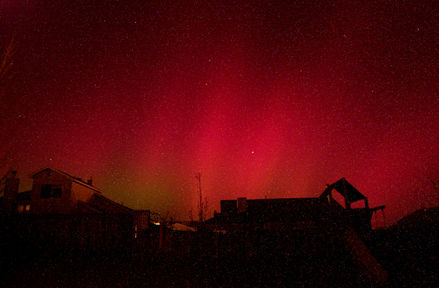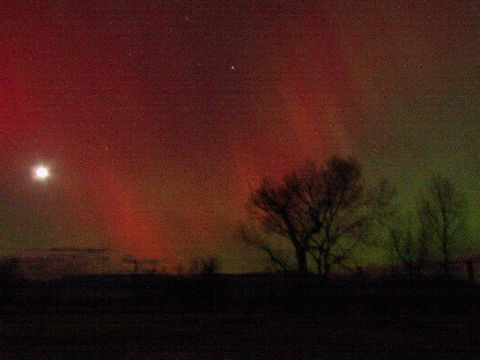Solar Flare Goes Off the Charts

Monday April 2 11:17 PM ET
Solar Flare Goes Off the Charts
BOULDER, Colo. (AP) - Forecasters said a solar flare Monday was the most intense they have seen in the current 11-year-solar cycle.
Space weather forecasters had to estimate its intensity, X-22 on a scale that only goes to 20, after sensors on a National Oceanic and Atmospheric Administration satellite could no longer measure it. They said the measurement could be off by plus or minus 2.
The flare caused static on radio frequency used to navigate boats and planes. Pilots in northern regions of the globe Monday were kept waiting for takeoff after the flare occurred at 5:52 p.m. EST, said NOAA space weather forecaster Craig Sechrest.
A solar flare is an eruption on the surface of the sun that releases radiation and particles toward the earth.
Saturday March 31 3:06 AM ET
Solar Flare Eruptions May Disrupt
Telecommunications
By JOSEPH B. VERRENGIA, AP Science Writer
BOULDER, Colo. (AP) - Intense storms raging on the sun made the night sky shimmer red and green as far south as Palm Springs, Calif., and could briefly disrupt telecommunications as the storms continue through the weekend, scientists say.
The biggest sunspot cluster seen in at least 10 years has developed on the upper right quarter of the side of the sun visible from Earth, according to satellite readings.
Friday night, the light from solar flares could be seen as far south as Palm Springs and was reported near Sacramento, Calif., as well.
``It has totally lit up the sky. We've had dozens and dozens of calls. People want to know what it is,'' said Bill Seigel, a producer at radio station KESQ in Palm Desert, 115 miles east of Los Angeles. ``Some people thought it was UFOs.''
Anthony Watts, a meteorologist in Chico, Calif., about 170 miles north of San Francisco, said the glow from the coronal mass ejection was interesting, but posed no threat.
``There's no danger, however there is the likelihood that we'll have radio or television interruptions,'' he said.
The sunspot, which is a cooler, darker region on the sun's surface, is caused
by a concentration of temporarily distorted magnetic fields. It spawns
tremendous eruptions, or flares, into the sun's atmosphere, hurling clouds of
electrified gas toward Earth.
The solar activity can produce an aurora in the night sky, typically over northern latitudes. The colorful, shimmering glow occurs when the energetic particles strike the Earth's upper atmosphere.
NASA scientists said a powerful flare that erupted Thursday rated a class X, the most potent category.
The eruptions triggered a powerful, but brief, blackout Friday on some high-frequency radio channels and low-frequency navigational signals, scientists said. They forecast at least a 30 percent chance of continuing disruptions through Sunday.
In addition to radio disruptions, the charged particles can bombard satellites and orbiting spacecraft and, in rare cases, damage industrial equipment on the ground, including power generators and pipelines.
Satellite and radio signals, and electricity power grids, could be disrupted by a huge outpouring of energy from the Sun this week.
Two "coronal mass ejections", containing as much energy as thousands of atomic bombs, exploded from the surface of the Sun earlier this week, after building up near the biggest sunspot seen on the star for the past decade. Now scientists believe there is a significant chance that on arriving due last night or today they could knock out sensitive electromagnetic systems orbiting the Earth, disrupt the ionosphere, which bounces radio waves around the globe, and even affect power lines at ground level.
Dr Steve Fossey, of the Mill Hill Observatory at University College London, said: "Satellites are at risk because these ejections contain highly charged electromagnetic particles, which can knock out the components inside them. It can also affect the ionosphere, which could cause the aurorae, or northern lights."
Sunspots appear and disappear on the Sun in an 11-year cycle that is now at its climax marked by the magnetic poles of the star flipping over, so that its magnetic "north" becomes south and vice-versa. Dr Fossey said: "The flipping happened in February, which marks the solar maximum."
The associated coronal mass ejections are billion-ton clouds of electrified, magnetic gas that solar eruptions hurl into space at speeds ranging from a few hundred to 2,000 kilometres per second (4.5 million mph). The latest have been thrown out from the surface near Noaa 9393, a sunspot that first appeared a month ago on the Sun's surface and that is so large that it is visible with the naked eye though nobody should look directly at the Sun, because that would cause immediate and permanent damage to the eye.
Sunspots appear black against the Sun's surface; they are actually cooler than their surroundings about 3,000C rather than 5,500C. Scientists reckon they are caused when magnetic fields below the star's surface reach the exterior, where the motion creates a huge store of magnetic energy that is eventually released in an explosive coronal mass ejection.
Some astronomers think that the two ejections from earlier this week will be followed by more intense ones from Noaa 9393. Joe Elrod, of the US National Solar Observatory at Sacramento, New Mexico, said: "The two small flares may be the precursors to the big one."
Home | Introduction | Prophecies | Directives | Order Form | Testimonies | Veronica | News | Photos | Bible | Magazine | Newsletters | Radio Show |
The electronic form of this document
is copyrighted.
Copyright © These Last Days Ministries, Inc. 2000 All rights
reserved.
Revised: August 01, 2022
https://www.tldm.org